Different types of German Shepherds (including long-haired and short-haired) excel in different areas, including obedience, herding, agility, and tracking.
Despite all kinds of German Shepherds being admired for these traits in addition to their loyalty, work ethic, and aesthetic beauty, your reasons for buying a German Shepherd may vary from others.
Some buy the dog for its perfect canine beauty, whereas others would appreciate a protective guard dog who excels in obedience and herding tasks.
The 5 different types of German Shepherds are:
- West German Show Line German Shepherd
- American Show Line German Shepherd
- West German Working Line German Shepherd
- East German Working Line German Shepherd/DDR
- Czech German Shepherd
The show line shepherds look the best, while the working line variety has the strongest work ethic and shows commendable agility and tracking abilities.
In this article, you will learn more about the different German Shepherd breeds, with their special skills in obedience, herding, agility, and tracking.
You’ll discover breed-specific pros and cons, the dogs’ looks, color, and size, and whether you should buy one.
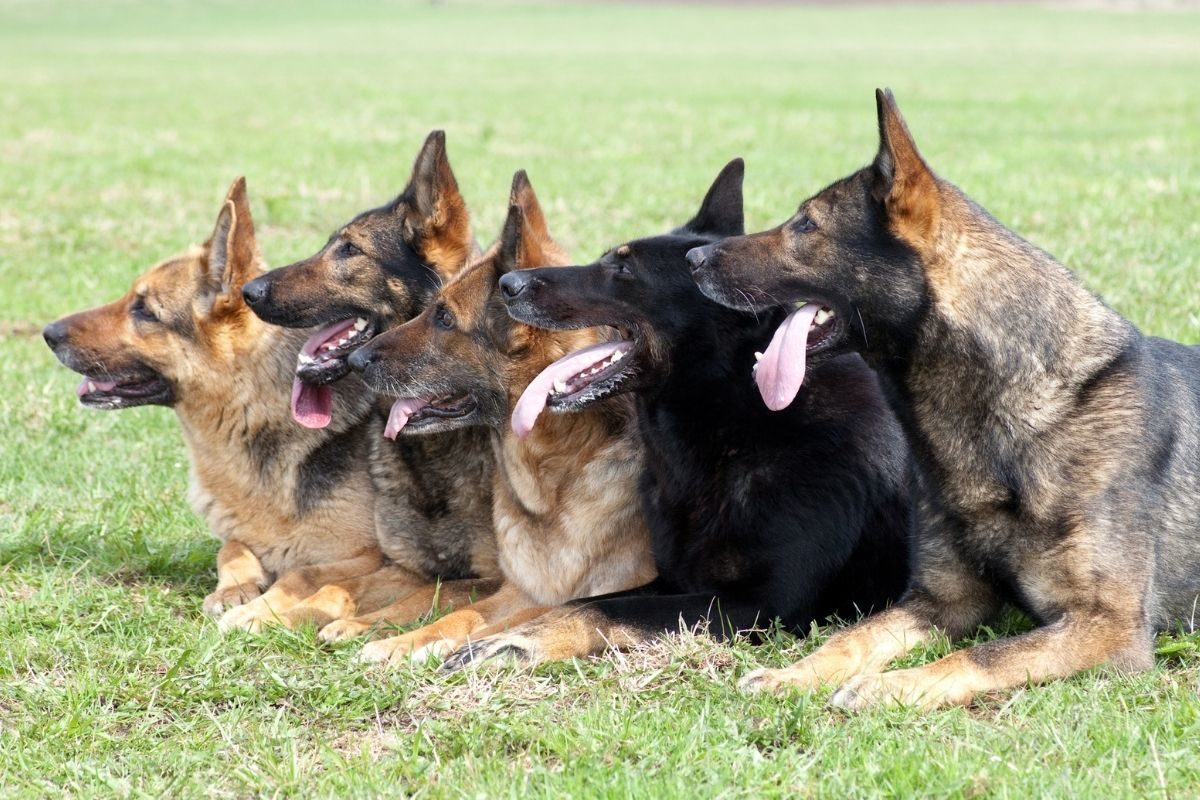
German Shepherd Varieties
There are five types of German Shepherds (breed variations), but we can sort them into two bloodlines, the show line and the working line, each excelling in obedience, agility, and tracking, respectively.
Show line varieties consist of:
- West German Show Line (also known as European Show Line)
- American/Canadian Show Line
Working line varieties are made up of:
- West German Working Line
- East German Working Line (also known as DDR Shepherd)
- Czech German Shepherd
You can learn more about all working lines here and their skills in obedience, agility, herding, and tracking abilities. Or check out the show lines here. Or, if you prefer, you can watch our video below:
But if you’re unsure of the bloodline and type, let’s look at the show-line dogs first, with their obedience training.
Show Lines
Let’s explore the two varieties of show line dogs.
American Show Line
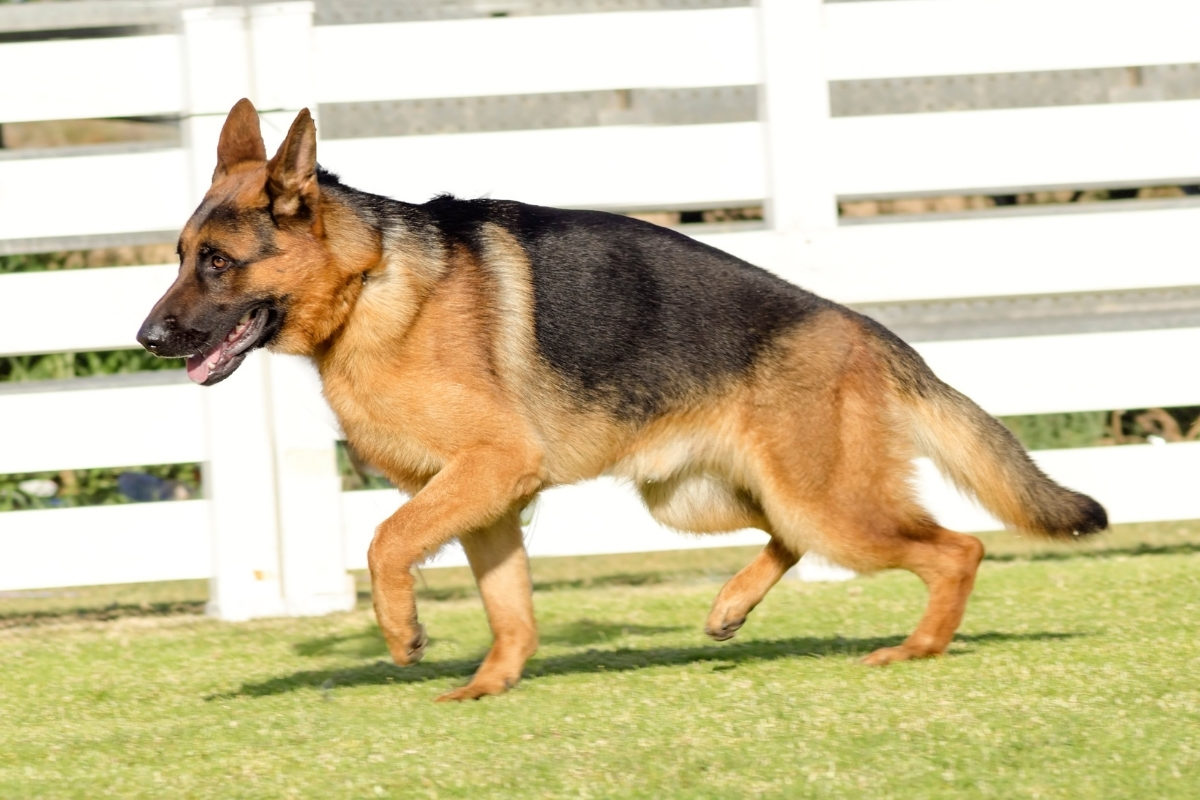
American Show Line shepherds, also referred to as Canadian Shepherds, come in caramel to tan color with a prominent black area (or bi-color as well) usually around the dog’s back.
These colors are featured heavily across the German Shepherd dog breed, but the exact location of tan and black may vary. Their training for obedience and tracking is equally notable.
This dog doesn’t stand out by color alone, but if you cross its color, size, and agility, you’ll be able to spot an American Show Line GSD at first glance.
These dogs can grow up to 26 inches at the shoulder for males and 24 inches at the same stature for females.
The size of American Show Line GSDs can depend on stud quality, nutrition, and the training they receive, especially in terms of agility, but ranges about 2 inches below the breed maximum.
In other words, American Show Line males will be between 24 and 26 inches while the females will reach 22 to 24 inches. Breeders can make a near-accurate guess of this while the dog is still a puppy.
The American Show Line is typically different from other kinds of German Shepherds found around the globe, not just in terms of physical traits but in their obedience skills as well.
In addition to their large size, they are more angulated and have a thinner face than their European show-line counterparts. In other words, you can tell an American Show Line due to its sloping topline.
American Show Line varieties can cost between $2000 and $2500 depending on rarity, breeder competition, and stud quality. Some people visit states with more breeders to get a better price.
Others find it more convenient and even wallet-friendly to go with the more expensive breeder who happens to be close by.
But before you make that commitment, you must ask yourself if the dog is ideal for you in the first place. American Show Line German Shepherds are best for those impressed by the GSD’s look but don’t expect too much (work-wise) from the dog.
Having said that, they are not devoid of the ability necessary for obedience training, often seen in Schutzhund or IPO training disciplines.
It is also ideal for getting this GSD type if you cannot meet the high-energy activity demands of other GSD varieties like those trained for Schutzhund or IPO.
Despite their obedience training aptitude, American Show Lines are family dogs but can be adopted by single owners as well.
West German Show Line
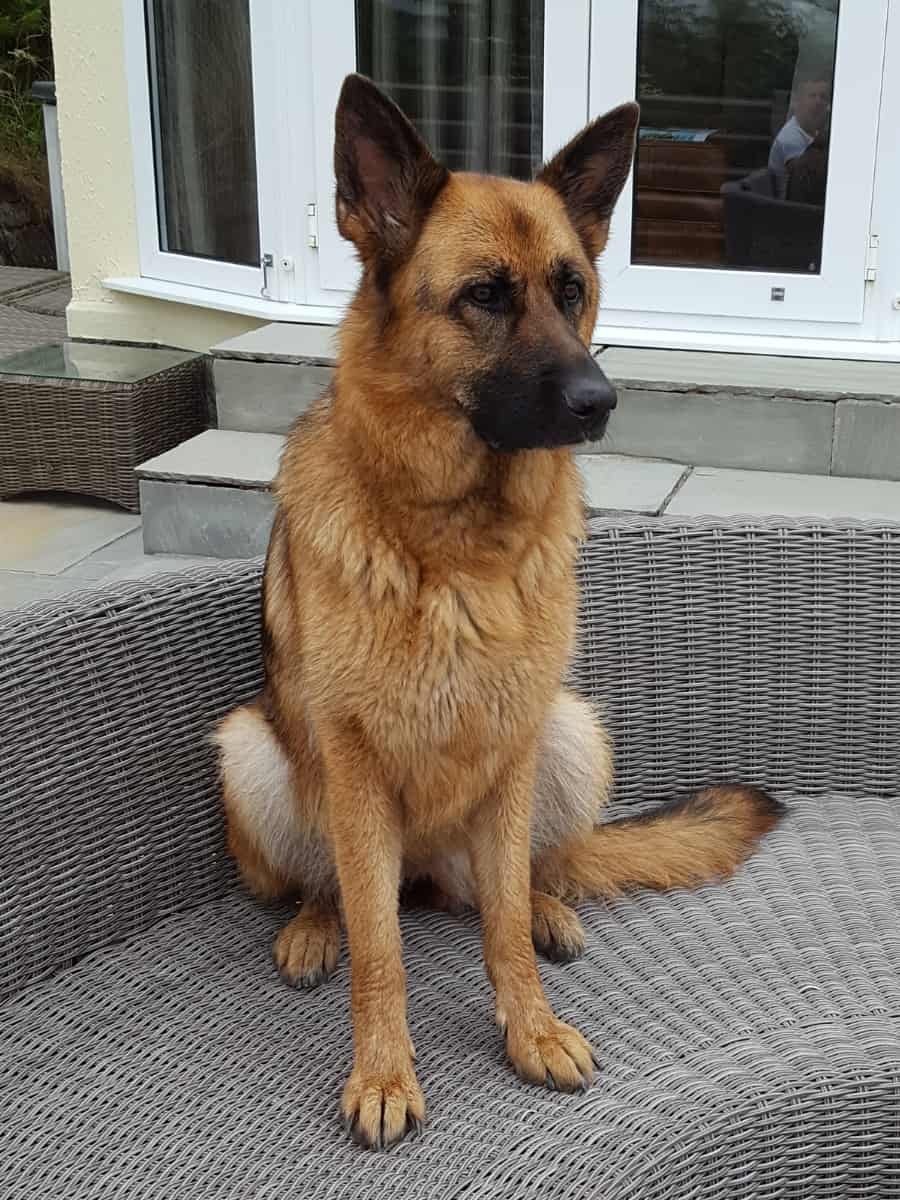
West German Show Line GSDs (European Show Line German Shepherds) have a significantly higher temperature hue than their American counterparts.
They have black and red fur, with the red bordering on deep tan. There are hints of light brown between the reds and blacks in the dog’s coat, and they predominantly display the saddleback pattern.
Trained in obedience, their ability to adapt to commands is exceptional, making them ideal candidates for Schutzhund or IPO training.
They are considered the most beautiful of all the German Shepherds. The West German Show Line also has an angulated topline; however, it is nowhere as severe as the American Show Line.
My German Shepherd, Willow is a West German Show Line; however, we don’t show her. We chose her for a mix of temperament, color, and looks.
Her training in Schutzhund has honed her obedience skills, reflecting her impressive ability to execute commands accurately.
These dogs, too, grow up to 26 inches as males and 24 inches as females, with a 2-inch buffer for the lower end. When you see at least a 24-inch adult male GSD with prominent red and black areas and a slightly sloping back, you can classify him as a West German Show Line German Shepherd.
A similar diagnosis applies to a 22-inch female adult. These dogs’ ability in Schutzhund or IPO closely matches that of larger adult German Shepherds, making their obedience training vital regardless of size.
Pro Tip! Remember to keep the breed maximum in mind when getting a suitable dog crate or accommodating his space in your home. And don’t forget, whether for Schutzhund or general obedience, training should be a key ingredient in your dog’s routine.
However, when you buy the dog, you’ll get him as a puppy with little to no information about how much he will grow. That’s why it’s always a good idea to see the sire and dam beforehand, as this can help give you an indication of size and quality.
Talking to a reputable breeder helps. Speaking with the breeder about the dog’s potential ability for obedience or Schutzhund training can also provide crucial insights.
You can expect to pay $2000 to $2500 for a high-quality Show Line German Shepherd puppy. Seeing the stud usually inspires confidence and helps justify the price tag.
Before making the commitment, it is also advisable to discuss the puppy’s potential for obedience training or Schutzhund with the breeder.
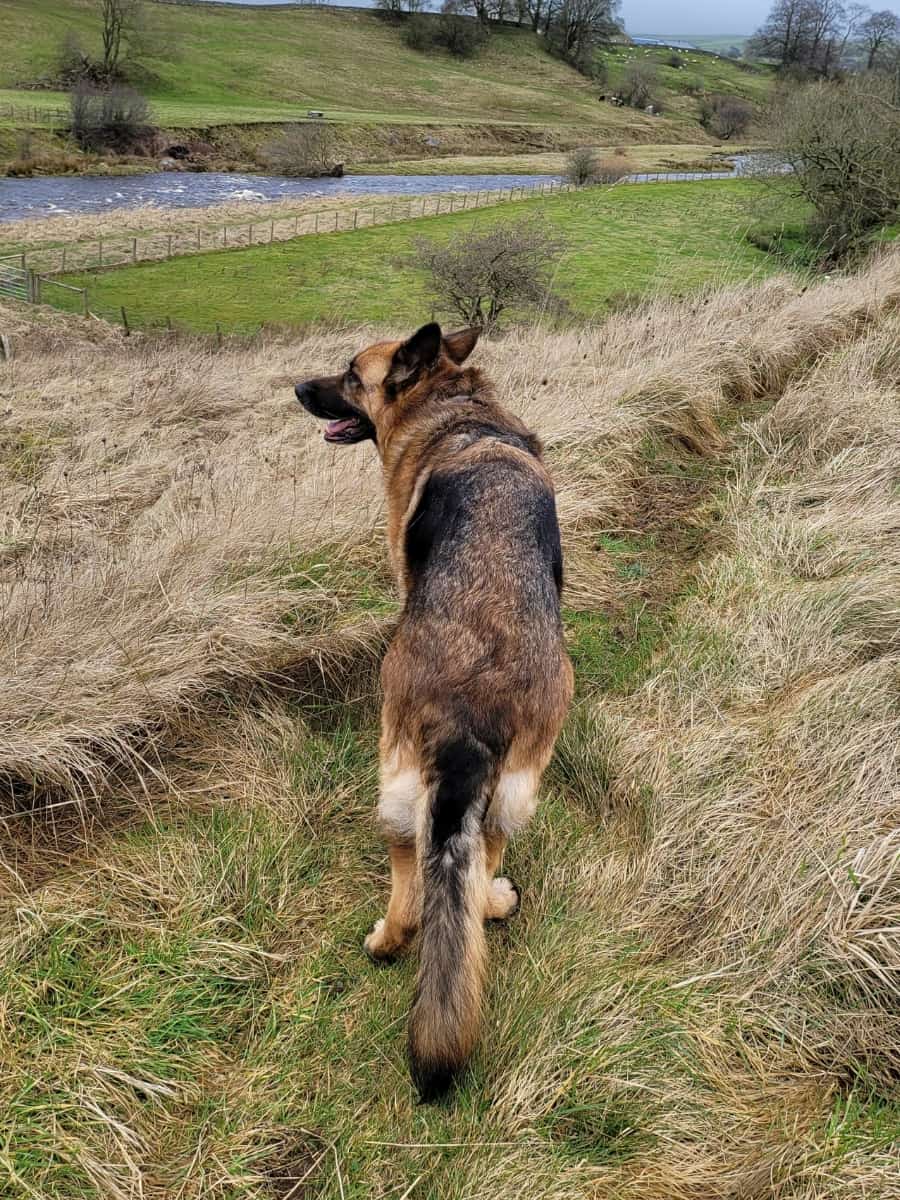
West German Show Line German Shepherds are great for families and those interested in dog pageants.
This type of German Shepherd is loving, protective, and eager to please but leaves much to be desired in stamina compared to working bloodlines, although many can also be working dogs.
Consequently, it has fewer physical activity requirements but is still pretty lively and is certainly not lazy. Despite this, they are perfectly suited to obedience training, and their ability to learn new commands is impressive, potentially making Schutzhund or IPO an excellent fit.
If you’re someone who often finds themselves engaged in various tasks and considers themselves mildly active, this type of German Shepherd, often used as a working dog, is perfect for you as he can accompany you on your walks.
Their characteristics as a breed are known for their endurance and loyalty, making them an ideal partner for an active owner.
European breeders have to submit their dogs for health and fitness testing and, hence, export more temperament-regulated dogs. Health testing includes screening for hip and elbow dysplasia.
Since Show Line dogs bred in America don’t have to go through a similar process, getting West German Show Line dogs means that the stud (or the stud that birthed him) will likely be healthier.
Working Lines
Let’s explore the three kinds of working line dogs.
West German Working Line German Shepherd
West German Working Lines come in various colors, but you’ll find most of them to have strong, rich colors. Many can appear almost entirely black with hints of cappuccino shade closer to the mid-limb region. Black and tan colors are common.
However, this description is expansive enough to cover many working variety GSDs and shouldn’t be taken as the sole identifying indicator of West German Working Lines.
In addition to being visibly darker, these dogs, common among working dog breeds, also possess characteristics such as more compact bodies than their show-line counterparts.
Their smaller bodies make them more athletic and suited for robust tasks, which means they demand more stimulation.
But if you, as an owner, actually want a dog that can engage your family with high energy, then a Working Line GSD is perfect. This perfection also comes on a budget.
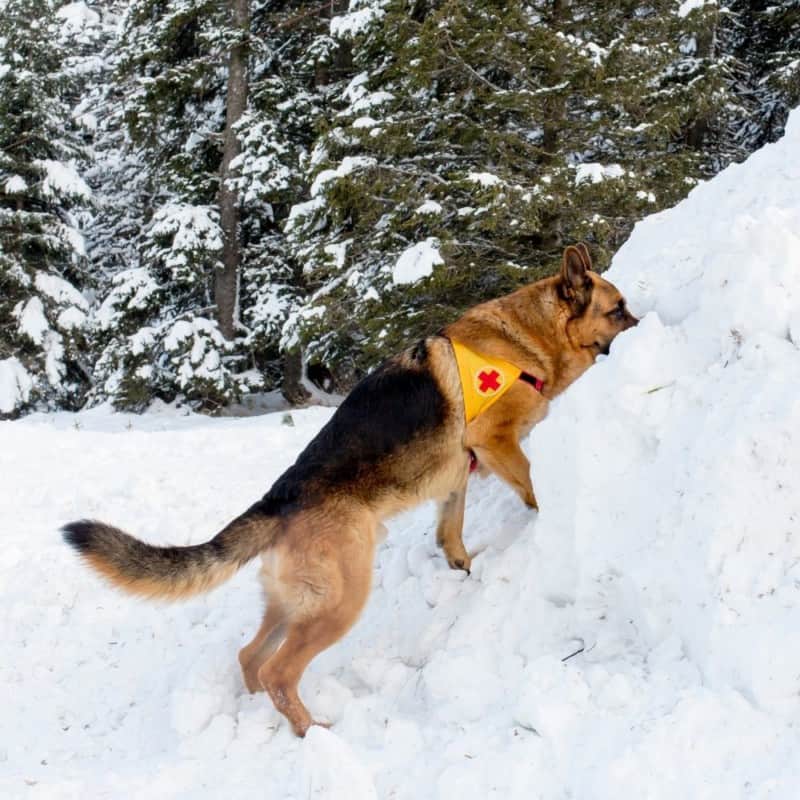
Show Line dogs are usually more expensive than the working variety, and you can expect to purchase a West German Working Line GSD for $1500 to $1800. Some breeders release working line puppies for as little as $700, while others charge over $2000 for a similar dog.
Ultimately many business factors like supply, demand, experience, reputation, and cost of doing business need to be factored in.
One might think that standard best practices like visiting the stud do not apply to working line dogs. That’s not true. You must always ask the breeder to show you the puppy’s parents, and you must observe the breeding conditions.
The environment plays an important role not just at the breeder’s but also at the owner’s home. So, before you get a West German Working Line GSD, you must ask yourself if the dog’s characteristics and tasks they are bred for align with your lifestyle.
It is said that the West German Line is the closest to the first dogs produced under the breed’s creator, Max von Stephanitz. Their strong working drive is what makes them today’s working dogs used in the Police, Military, Search and Rescue, protection work, and loads more.
If you are athletic or have a teenager who is highly interested in physical fitness, then the dog’s nature aligns with your family’s lifestyle.
Aside from stimulating physical activities, West German Working Line German Shepherds also crave attention and appreciation, much like what an owner would expect to give his faithful companion.
While one must be prepared to give attention to any pup one brings home, this is especially true for working-line dogs that are bred to be eager to please. Their owner’s attention and the tasks provided to them are their ultimate rewards.
So before welcoming a German Shepherd, including the West or East varieties, to your home, ensure it aligns with your lifestyle and standards. These dogs are purpose-bred; they need an owner equally committed to their emotional needs as they are to their physical ones.
Finally, West German Working Line dogs have an intimidating presence – an excellent deterrence for intruders and even pests. So, whether you are a farmer or an investment banker, these German Shepherd dogs are bred for a wide range of purposes, and thus, they will make efficient pets.
East German Shepherd / DDR German Shepherd
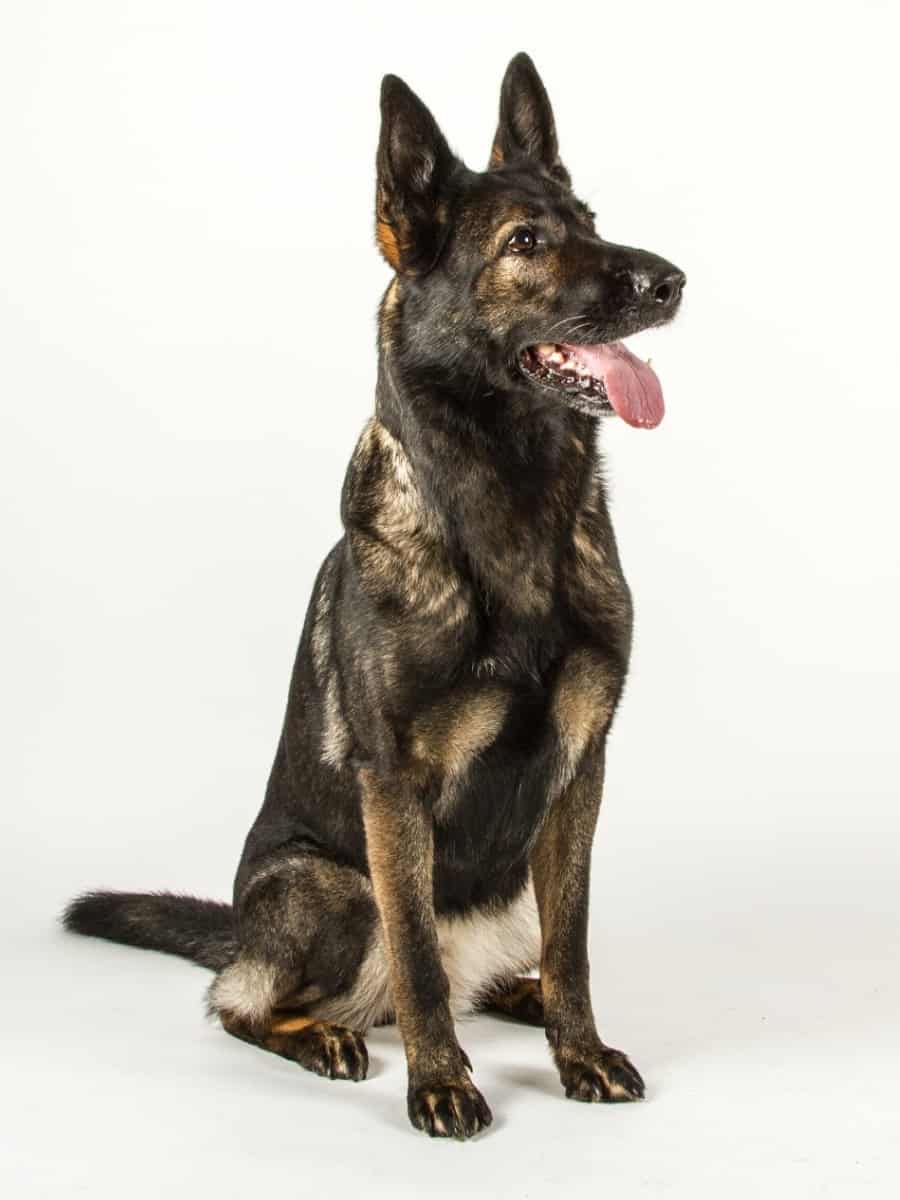
East German Shepherds, a German Shepherd breed variant honoring specific standards, hail from East Germany, which once used to be a separate country called Deutsche Demokratische Republik, shortened as DDR.
While you don’t have to figure out how to pronounce Demokratische or Deutsche, you must learn how to handle these high-energy dogs.
The East German Shepherds, bred with impeccably high standards, showcase unique anatomy. With cappuccino and tan swapped with sable or sober grey, these German Shepherd dogs have a darker appearance with prominent black fur across their backs.
They are smaller than Show Line GSDs, but not by too much. At least height-wise, the bigger DDR Shepherds match smaller show-line shepherds.
Their purpose-focused breeding is evident in their physical structure. Their backs, alongside their fur color, give away the difference.
There will be no arch or slope in an East German Shepherd’s back because they were literally bred for patrol, and asymmetry between the front and back limbs would be disadvantageous for such work.
Interestingly, though working-line German Shepherds are generally cheaper than show-line shepherds, East German GSDs might be an exception.
The high standards adhered to in their breeding and their purpose of protection have resulted in their prices coming pretty close to the top-tier show variety.
The rarity and robust health of these German Shepherd dogs is another contributing factor to their high prices.
Pure DDRs are not only hard to find but also live healthier due to genetic predisposition to the illness being ruthlessly bred out at the stud-selection stage back in the days of Deutsche Demokratische Republik.
Notably, aside from living longer, these dogs work better due to discipline and work readiness being factored in by the DDR’s breeding program that led to the breed’s creation.
Consequently, the dog is fit for physically fit single owners and families wanting a guard dog. Their intimidating presence, alongside their devotion to not just you but your entire family, makes them the perfect, practical companion. Their purpose as a protector is undeniably evident.
Despite being almost immune to most disorders and diseases that most GSDs are prone to, East German Shepherds cannot defy physics and come with the same drawbacks as any big dog: the wrong crate, crate pad, or bed can seriously affect their joints.
Czech German Shepherd
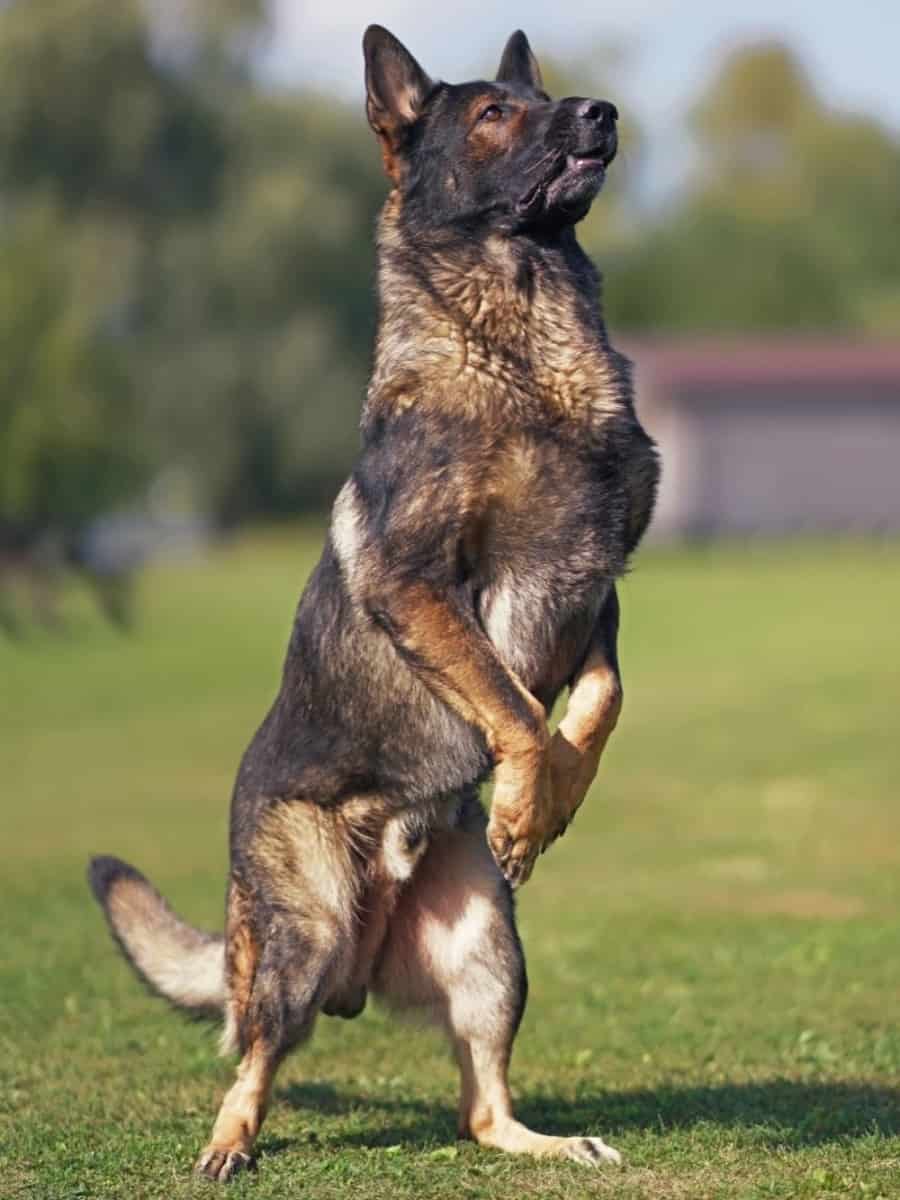
Czech German Shepherds, another meticulously bred variant adhering to specific standards, originate from the Czech Republic, or they would have a different name. They are also a working variety and come relatively cheaper than show-line shepherds.
Investing in these German shepherd dogs might not cost a lot of dollars, but you’ll spend a lot of calories keeping up with them, given their high drive and purpose of being vigilant protectors.
They are almost entirely black, sable, or a mix of the two and resemble DDR Shepherds in many visual traits. Their sizes are pretty similar, but it is best to get confirmation from the breeder.
To tell DDR Shepherds apart from Czech Shepherds, you’ll need to focus on the non-black areas of the dog’s body. You’ll witness a sable where there are greys in an East German GSD. Still, this isn’t an ironclad rule.
Aside from being similar in looks, these dogs are also pretty close to DDR Shepherds in personality and maintenance demands. You will need exciting puzzles and games to keep him occupied throughout his development.
Daily walks are necessary, and you’ll have to engage in catch-and-fetch games or race with your doggo to keep him occupied.
You’ll need to raise the dog to be social so he doesn’t get unnecessarily spooked. A dog that cannot distinguish between everyday occurrences and danger can attack people, especially strangers, even when there’s no threat.
Czech Shepherds can cost the same as DDR Shepherds, and while prices vary based on availability, you can expect to pay at least $1200 for a Czech GSD. But before you try to find a suitable breeder, you must be positive that a Czech GSD is the right fit.
While Czech GSDs fall strictly within the working line category, they are lighter than many Working Line German Shepherd varieties and are visually more appealing.
However, the visual appeal aspect can be subjective, and looking at the stud can help you assess whether the puppy will grow into the kind of pet you have in mind.
More than the looks need to be factored in when selecting a dog. Czech Shepherds have incredible stamina and an intense need to be liked. This makes them the perfect cross between guard dogs and family pets.
Like most working lines, they will love you and your family and jump to protect what they love. That also comes with a drawback: you need to teach your Czech Shepherd to differentiate between threats and norms.
If your dog sees what you consider normal as a threat, you’ll end up with an attack incident in seemingly normal conditions.
Fortunately, Czech Shepherds are intelligent enough that if you train them right early on, they can be pretty social and discern between actual threats and the normal. Intelligence stands as the primary difference.
Finally, the rule about fitness applies to this variety of German Shepherds as it does to any Working Line GSD. Czech Shepherds are full of energy and need an outlet.
As the dog’s guardian, you must provide that outlet through games, walks, and other activities. If you have productivity problems, getting a Czech Shepherd might not be the right call.
But if you are an active individual with enough space in your home and your heart for an eager, high-energy dog, then this breed is ideal for you.
Which Type of German Shepherd is Right For You?
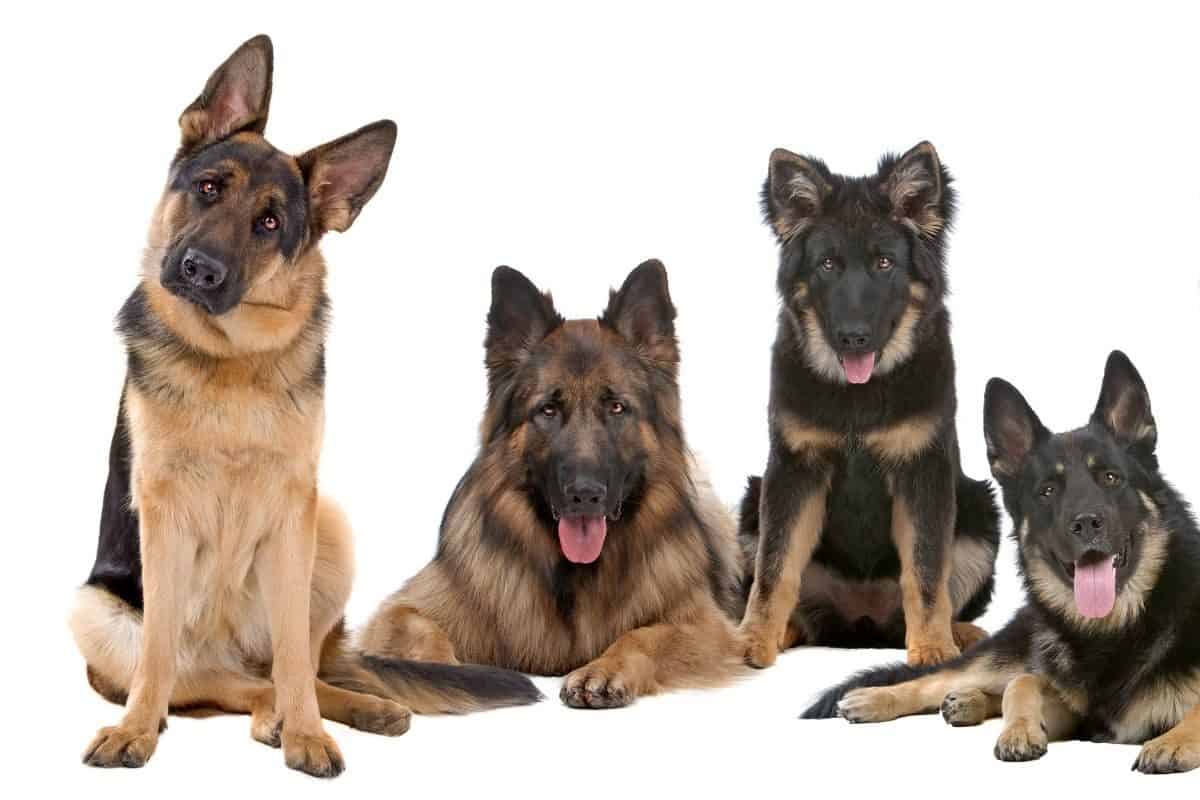
There seem to be as many categories of German Shepherds as there are actual German Shepherds. But ultimately, your choice comes down to two options: the working line dogs vs. show line ones.
You’ve learned more about the specifics of each type within the working and show categories, but here are a few pros and cons to consider which type of GSD is right for you.
| Pros of Show Line GSDs | Cons of Show Line GSDs | Pros of Working Line GSDs | Cons of Working Line GSDs |
|---|---|---|---|
| Considered better-looking by most people | Can have more health complications because looks are prioritized over health inbreeding | Higher stamina and work ethic can double as practical guards and helpers | More suited to owners with some experience |
| Bigger and bulkier can deter intruders in metropolitan settings | More expensive because of generally higher demand. | Can be trained to be hunting partners | Require more active engagement |
| Can enter pageants and dog shows | Darker, look more intimidating (better suited for suburban settings) | ||
| Lower working drive – so requires fewer active hours | Cheaper because people flock toward show-line Shepherds |
FAQs
Which GSD is best for families with children?
While all varieties of German Shepherds can make great family pets, the West Show Line German Shepherd is often considered the best choice for families with children. These dogs are known for their friendly and outgoing personalities, as well as their loyalty and protectiveness. They are also typically less high-strung than some of the other German Shepherds, making them easier to train and handle.
Are there any health concerns that are specific to certain variations of German Shepherds?
Some German Shepherd breeds may be more prone to certain health concerns. For example, Working Line German Shepherds may be more prone to hip and elbow dysplasia, while American Show Line German Shepherds may be more likely to suffer from skin allergies. It’s essential to be aware of these potential health issues and to seek advice from a reputable breeder or veterinarian.
Are certain kinds of German Shepherds more prone to behavioral issues than others?
Temperament can vary between different kinds of German Shepherds, with some varieties being more prone to specific behavioral issues than others. For example, Working Line German Shepherds may be more prone to aggression and anxiety, while American Show Line German Shepherds may be more prone to separation anxiety.
However, each dog is an individual, and factors like training, socialization, and environment can also influence temperament. It’s essential to do your research, talk to a reputable breeder or rescue organization, and work with a qualified trainer to ensure that your German Shepherd is well-behaved and well-adjusted.
Can I train any type of German Shepherd to perform specific tasks or roles?
All kinds of German Shepherds are highly trainable and can be taught to perform a wide range of tasks and roles. However, certain varieties may be better suited for specific jobs than others. For example, Working Line German Shepherds are often used as police or military dogs, while American Show Line German Shepherds are more commonly used as show dogs or family pets.
Regardless of the type of German Shepherd you have, it’s essential to start training early and to use positive reinforcement techniques. Consistency and patience are key when training any dog, and German Shepherds are no exception.





